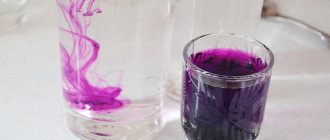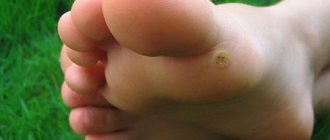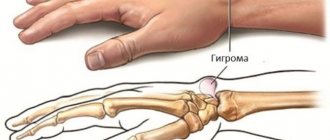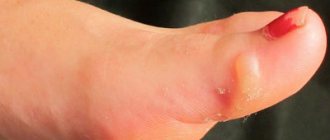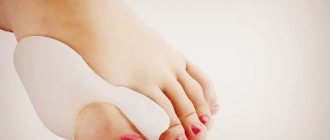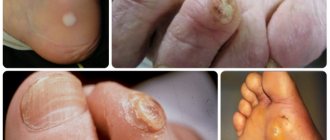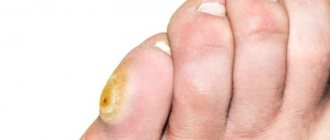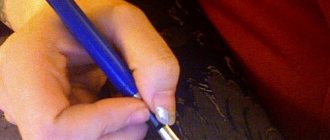How to remove a callus from a finger?
The situation with the appearance of calluses on the hands is familiar to every person. The symptom may be caused by the specifics of work or overexertion on the eve of the event. It’s easy to get rid of negative manifestations.
For this, there is an arsenal of folk methods and pharmaceutical preparations. It is necessary to first understand the reasons for the formation. By excluding them from your life, you will be able to prevent the appearance of calluses in the future.
Treatment options
It appears that all three main types of calluses can appear on the fingers: wet, dry and core, and the treatment method should be chosen depending on the type of callus.
At the doctor's
Generally, wet calluses and simple dry calluses respond well to treatment at home. Qualified medical care is necessary in the following cases:
- Core calluses cannot be treated at home and cause a lot of inconvenience due to their horny core growing into the soft tissue.
If such a formation occurs, you should visit a dermatologist.
The doctor will prescribe one of the options for removing the rod: drilling, laser burning, cryodestruction (freezing with liquid nitrogen) or electrocoagulation (burning with high-frequency electric current). Purulent calluses appear when a blister becomes infected, burst or is still filled with liquid, as a result of which the process of suppuration begins.
This is a very dangerous complication.
If pus appears, you must immediately see a surgeon.
Pharmacy products
Currently, pharmacies sell many modern products that allow you to effectively deal with calluses at home.
- Treatment of a wet callus on a finger is aimed primarily at preventing infection of the wound.
To do this, the affected area of the skin is treated with liquid antiseptics, such as hydrogen peroxide, furatsilin, chlorhexidine.
Antibacterial ointments have proven themselves well: levomekol, syntomycin liniment, etc. The ointments are applied in a thin layer to the callus and the skin around it, sealed with a bactericidal plaster, and the bandage is changed twice a day.
Before removing the accumulated keratinization, it must be softened.
To do this, use various ointments, liquids and patches based on salicylic and benzoic acids.
Ointment or liquid is applied only to dry calluses, since the acids they contain can damage healthy skin. To do this, the site of application of softening agents must be limited using an adhesive plaster with a hole pre-cut to the shape and size of the callus.
The ointment, liquid or patch is applied to the skin, previously steamed in warm water, according to the instructions for use, usually the application time ranges from 12 to 72 hours. If necessary, the procedure can be repeated several times. After final softening, the keratinized callus is carefully removed using pumice.
A more radical agent is trichloroacetic acid. Its use should be treated with extreme caution, as improper use can result in chemical burns.
It is worth noting that many athletes and musicians do not require removal of dry calluses on their fingers, since the thickened stratum corneum protects the skin from damage.
Traditional methods
Among the recipes of traditional medicine you can find a lot of remedies that can help you cope with calluses on your fingers.
For the treatment of wet calluses, perhaps the most recognized herbal remedy is widely used - aloe leaves. A paste of crushed leaves is applied to the rubbed area as a compress. Aloe juice relieves swelling, pain and inflammation, accelerates tissue regeneration and prevents pathogens from entering the wound.
There are also many folk remedies for softening and removing dry calluses, here are just a few of them:
- Celandine juice is widely used in the treatment of skin diseases such as hard calluses and warts.
- Compresses made from crushed aloe leaves are used not only to treat wet blisters, but also to soften dry keratinizations.
- At night, you can also apply compresses of grated garlic and onion to the calluses.
- An excellent nourishing and softening compress can be made by steaming crushed calendula flowers.
- Do not neglect propolis compresses. To do this, you need to warm up the propolis, apply a gauze pad with warm tincture to the callus and cover it with an adhesive plaster.
- You can soften dry calluses before using compresses or ointments in an alkaline soap and soda bath: add 3 teaspoons of baking soda and a small amount of soap shavings per liter of warm water.
It is also not recommended to overuse compresses made from organic acids - incorrect use of acetic or citric acid can lead to burns.
How to remove dry callus yourself
The procedure for how to get rid of dry calluses on your toes or heels can be done independently. It is not difficult to cure this disease, the algorithm of actions is as follows:
Steam your feet well in hot water
You need the maximum temperature that you can tolerate (this is an important condition). This helps to effectively soften rough skin, making it easier to remove.
For better effect, you can add tea tree oil and mustard to the liquid. To obtain an antiseptic effect, you can add a decoction of medicinal herbs. Keep your feet in hot water for at least 30 minutes. Next, use a pumice stone to cleanse the skin on the sole of your foot, heel, or toes. The next step is to lubricate your feet with moisturizer. Children's products and pharmaceutical ointments are suitable. After treatment, feet should be wrapped in film to prevent the cream from being absorbed into clothing, and put on cotton socks.
Calluses often form on the toes; the little toe is most often affected. If the situation is not advanced and the neoplasm is not of the fibrous or vascular type, you can get rid of it yourself at home. You may need more than one procedure. The best effect will be obtained by combining baths and medications for healing. The procedure algorithm is as follows:
- Steam your feet thoroughly by soaking them in warm water for at least 30 minutes.
- Next, you need to treat the stratum corneum of the callus.
- Apply a little anti-callus cream to the damaged finger and cover with a band-aid. Preparations with salicylic acid are well suited; you can find them in the pharmacy.
No less often than on the little finger, a corn forms on the heel. Most often it does not cause pain, but it is better to know how to get rid of dry calluses on the feet. Unlike the little toe, where the problem can be quickly solved with a laser, foot baths are the best option for this type. They need to be done as follows:
- Add enough water to completely cover your feet. Dissolve a piece of soap (or shavings) in it.
- It is necessary that the liquid is of medium temperature, but not hot.
- You should steam your heels for at least 20 minutes. Add some hot water from the kettle to maintain the desired temperature.
- Dry your feet, rub the keratinized skin with a pumice stone or a special grater.
- You can get the maximum effect if you add additional ingredients to the liquid: mustard, sea salt, celandine, baking soda, chamomile, rose hips.
Methods to Prevent Calluses Formation
To reduce the likelihood of calluses, you should:
- Exercise the correct grip while practicing on the horizontal bar. You need to grasp the bar with your fingers, and not clasp it with your entire palm. With this grip, there is more stress on the fingers, hands and forearms, but the palm is less damaged.
- Choose crossbars with a large diameter for training. The thicker the horizontal bar or bar, the wider the grip area between the hand and the sports equipment and the less pressure exerted on the skin. If there is no thick bar or wide bar nearby, you can increase the thickness of the projectile yourself using a bar extender purchased at a sporting goods store or a wrapped towel.
- Use specialized gloves. They are equipped with additional lining at the base of the fingers, i.e. in areas that are most susceptible to the formation of calluses. Gloves are available in several types, differing in the degree of grip. To perform static exercises - regular pull-ups, you need to purchase gloves with a high degree of grip. If you will be performing exercises on the horizontal bar that require turning your arms, you need gloves with a low degree of grip.
- Regularly moisturize your skin by applying cream to your hands. Dry skin is prone to calluses and cracking.
- Use special hand pads. You can purchase branded leather pads or make them yourself from adhesive patches.
- Rest. During training, you need to take breaks and give your palms a few seconds of rest.
- Use magnesium. Magnesia is a powder made from magnesium salts. It is actively used in sports, as it increases friction and reduces sweating in the palms. Magnesia dries out the skin, so after training with it, you need to wash your hands and apply moisturizer to them.
Note! Using large amounts of powdered magnesia in small enclosed spaces has a negative effect on human lungs
Causes
Multiple factors lead to calluses on the hands. They are divided into 3 large categories. Calluses occur as a result of physical activity, professional activity, and vitamin deficiency.
The most common cause of calluses on the palms is physical exercise and work activity. The skin is rubbed into calloused formations while playing sports or working in the garden. Athletes get them from exercises on the horizontal bar, parallel bars, and with a barbell. Amateur gardeners rub their palms and fingers while working with shovels, pitchforks, and hoes.
With constant friction, long-healing blisters filled with liquid or dried out crusts appear. Wet calluses are formed as a result of irregular exercise. First, lymph accumulates under the skin. If the friction force increases, the capillaries in the blisters burst and fill them with blood.
Calluses are formed as a result of professional activities. This leads to playing plucked instruments (usually a guitar, less often a harp, a balalaika), and working in various workshops. The palms and fingers are constantly in contact with the instrument, the skin rubs against it, which leads to damage. In this case, dry calluses are mainly formed.
A deficiency of retinol and tocopherol in the body makes the skin dry and hypersensitive to mechanical stress. The epidermis is easily exposed to irritating factors. In case of vitamin deficiency, it is necessary to conduct 2 courses of vitamin therapy annually. A balanced diet helps to avoid the problem. The menu should include foods enriched with vitamin A and E: vegetables and fruits rich in carotene, vegetable oils.
Types of calluses on hands
- Dry callus.
With prolonged exposure to friction, epithelial cells turn into dense scales, layered on top of each other, and protect the diseased area from further damage. In appearance, callous tissue is dense, rough, rough, painless, and can be easily cut off with a pedicure knife. On the feet, these are usually corns. Dry calluses are difficult to deal with; over time, they reappear in the same places. - Wet callus.
It forms on more delicate and thin areas of the skin and is a bubble filled with liquid. To heal such calluses, it is enough to puncture the blister. It is not recommended to remove the skin, since in this case it serves as a biological dressing that protects against infection. Such calluses go away quickly and without leaving a trace. - Core callus.
This type of callus can be painful and cause a lot of discomfort. It appears more often on the lateral surfaces of the fingers. Horny tissue grows deeply into all layers of the epidermis, irritating nerve endings and causing discomfort. Dry callus is the most difficult to treat.
Pharmacy products
First of all, you should pay attention to pharmaceutical products for the treatment of calluses. They are suitable for emergency treatment of opened calluses, as well as for prolonged treatment
The first results are observed 1-2 days after therapy.
External preparations
The application of local preparations accelerates the process of tissue regeneration and reduces the risk of a secondary inflammatory process. Depending on the goals of therapy for various calluses, treatment of wet and dry callus is distinguished. In the first case, the goal of treatment is to prevent infection and accelerate the healing of the skin. For core and dry calluses, the drug should soften and exfoliate the affected skin, bring the core callus out.
To soften rough skin with dry calluses, the following is prescribed:
salicylic acid (20%);
carbolic acid;
lactic acid (3%).
These solutions are applied locally. Before application, the skin is steamed well, rubbed with a pumice stone or a manicure file. Afterwards, apply a patch with a pre-prepared hole the size of a callus, drop in any of the compounds and seal with a second patch. This procedure can be carried out several times a day.
Treatment of callus blisters involves the use of the following medications:
Levomekol or Levomycetin (only with risks of suppuration);
cream Doctor;
Vishnevsky ointment;
zinc-salicylic paste;
Nazosol-911.
Before applying the preparations, the skin of the hands is thoroughly washed with soap, dried without damaging the structure of the bladder, treated with an antiseptic and the medicinal composition is applied.
First aid for a burst callus
It is generally considered impossible to open a callus on your own, but with proper organization of the opening there is nothing life-threatening. In addition, it is recommended to remove the blister on the hand to avoid compromising its integrity in the most inappropriate place (especially when antiseptic treatment is not possible). To remove a callus yourself, you must:
wash your hands with soap;
treat the skin with a solution of Furacilin, Chlorhexidine;
heat the needle over the candle;
pierce the bubble at the base (you can make several punctures);
wait for the liquid to come out;
treat with an antiseptic, apply a disinfectant and apply a bandage.
If the callus bursts, you should wash your hands thoroughly and treat the affected area with an antiseptic. If the skin is preserved, then under no circumstances should it be torn off. Firstly, the peel will help prevent primary infection if prompt medical care is not possible. Secondly, the risk of scar tissue formation is reduced significantly. It is unacceptable to treat a burst callus with alcohol solutions due to increased local irritation.
After antiseptic treatment, it is better to apply Levomekol or Levomycetin cream with an antibiotic to the callus. This will reduce the risk of infection, eliminate bacterial microflora, and quickly tighten the skin.
Stickers and patches
Any callus needs protection and fixation with medicinal compounds. Adhesive patches are widely used for these purposes. Pharmacy chains offer a wide range of different sticker options for any type of callus. To treat exposed callous blisters, it is enough to use a hygienic patch with antibacterial impregnation. When treating dry or core calluses, the following patches are prescribed:
Salipod. The patch contains sulfur, rubber, salicylic acid. Before gluing, the skin is steamed, the upper stratum corneum is removed, the required diameter is cut out and applied to the callus. You can apply a regular adhesive plaster on top to more securely fix the treatment layer. After two days, the patch is removed. If necessary, the procedure is repeated until the callus with the stem completely disappears.
Chinese patches. Contains propolis, hawthorn tincture, salicylic acid, scolopendra. Among the advantages are good fixing properties and less aggressive effects. Considering the plant composition, the risks of developing allergic reactions are high.
Korean patch Luxplast. The drug has many advantages: reliable fixation, waterproofness, no pain during separation. Usually, several procedures are enough to completely exfoliate the rough tissue of the skin of the hands and remove it.
Before gluing, it is recommended to make a steaming bath for your hands with salt, essential oils, and natural herbal decoctions. After steaming, it is recommended to remove the first layer of skin from the surface of the callus using a file, scrub, or pumice stone.
Treatment of calluses and corns. Modern methods of therapy
Treatment of calluses is not the biggest problem of modern medicine.
But calluses cause inconvenience, and they just look ugly. Therefore, their competent removal determines the comfort of human life. Depending on the tissue structure, calluses are divided into:
- dry – normal roughening of the skin, without a cavity;
- aqueous - rubbed skin forms a cavity in which there is a colorless, watery, odorless liquid;
- blood - the same cavity, only with blood content;
- calluses with a core are the same dry calluses in which, due to constant irritation, a compaction has formed in the thickness of the tissue (core) in the same place.
Corns are diagnosed separately. The difference between them and calluses is that:
- they are usually smaller in size;
- “built” from a compacted center, around which there is a circular (circular) inflamed area of skin;
- painful even with slight pressure.
Removing corns, like calluses, is not a complicated procedure.
A quick method to get rid of dry calluses
To get rid of calluses that are not amenable to other treatment methods, you can use a time-tested medicine made from boiled eggs. It will take only 3-5 days to treat the most stubborn formations.
Recipe:
Boil a fresh chicken egg. Peel carefully, being careful not to damage the film that is located between the shell and the white. Use the film immediately - it must not dry out.
With the wet side, place the removed film on the dry formation on the dermis. Place a patch on top or secure the product with a bandage compress. Leave for 5-8 hours. During this time, the film will dry, effectively softening the callus. After removing the product, walk over the affected areas of the dermis with fine pumice - most of the callus will be completely removed.
Treatment of calluses, basic methods
You can get rid of roughening (callus) of the skin in different ways. Treatment for calluses depends on their type and severity. In the arsenal of doctors are:
- therapy with medications that “dissolve” skin roughness;
- anti-callus patches;
- surgical removal (excision);
- The most modern method is laser removal of calluses.
Removing calluses using surgical instruments is performed not only by surgeons, but also by podiatrists - specialized specialists who deal exclusively with the feet.
Prevention
Why wait for calluses to appear if they can be prevented? By taking care of your health in advance, you can avoid unnecessary hassle in the future. In order to prevent the appearance of calluses, you need to follow a few simple rules:
Avoid direct contact with mechanical objects on the skin. The most common cause of buildup is excessive friction, so it is recommended that you wear gloves when performing difficult physical work.
After work, you need to wash your hands and thoroughly lubricate them with moisturizer.
Spa treatments will help your hands relax and soften rough skin. It is recommended to use creams with a protective effect. After applying this product, a silicone film is formed on the skin, which will reduce friction and prevent dirt from getting into microcracks.
Writing less means typing more. If a person develops calluses due to the friction of a pen and his professional activity is related to writing, but he has the opportunity to type on a computer or typewriter, then he should not neglect it.
Writing technique. Calluses can occur due to improper writing technique. If you slightly change the way you hold the pen, the callus will disappear over time. Typically, a callus appears on a “weak” spot, which is located on the joint where the phalanges of the middle finger meet. If you hold the handle in the area where the pad of your middle finger is located, friction will be significantly reduced. In order to get used to the new method, you need to practice a little.
Comfortable handle. The pen plays a very important role for comfortable writing. There are writing utensils that have a hard core and create friction, which contributes to the development of calluses.
People prone to the appearance of growths should pay attention to the presence of rubber pads when choosing handles.
Special attachment for the finger. It can prevent unnecessary contact of damaged finger skin with the body of the pen.
The silicone nozzle has two holes: one for fixing the handle, the other for your finger. This device will protect the callus on the middle finger from friction.
Advice! You can only choose a comfortable pen for writing through experience, based on your preferences. If the handles do not satisfy the requirements and continue to rub the callus, then you can experiment a little. For example, stick a soft patch on a writing object.
Preventing calluses
When working, you must use protective gloves, talc, glycerin or panthenol cream. Don't forget about regular hygiene procedures. Keep your hands clean and apply a rich cream at night. At the initial signs of the appearance of calluses, use the above methods to combat them. The main thing is to prevent the formation of large, rough, dry calluses, which will be extremely difficult to get rid of.
Make an appointment by phone or.
Treatment methods
There are many different methods for treating such tumors. But first of all, it is necessary to get rid of the factor that provokes their appearance.
Effective means
If the tumor has a rod, it will be difficult to remove it. For such dry tumors, preparations based on lactic or salicylic acid are best suited. Calluses can be removed using a solution of sodium hydroxide, which corrodes dry growths. They can be removed by freezing them with special preparations. The list of the most effective pharmaceutical products includes:
- Verrucacid. The main substances of the drug are metacresol and phenol. The product promotes the growth of young tissue. The solution is very aggressive, it literally burns out the growth. It must be used several times a day, applied to dry skin. Do not apply the product to healthy areas of the dermis.
- Salicylic ointment. The product is very popular due to its low price and high efficiency. Ointment for calluses on the hands softens the neoplasm well. After a few days, you can remove the callus using a pumice stone. Apply the product twice a day only to the affected areas of the skin.
- Feresol. The drug is a mixture of tricresol and phenol. It is considered very aggressive, so it is recommended to apply it with a cotton swab to the growth itself. Contact with healthy skin may cause burns. Use the product once.
- Cryopreparations. To remove a callus on your finger, you can use creams and ointments that freeze the growth. After using them, the upper layer of skin is deep frozen and after a few days the callus disappears. In this place, a new and tender dermis appears. The most popular drug is Cryopharma.
- Lactic acid. This product is not very aggressive. It gently dissolves dry growths without causing burns to healthy areas of the skin. In the pharmacy from this series you can purchase Effect, Green Pharmacy or Antimozolin. Those who engage in heavy physical labor are recommended to use such drugs.
Folk recipes
Traditional medicine methods are very effective. A variety of recipes makes it possible for each patient to choose the appropriate remedy for the treatment of calluses. The most popular treatment options for dry tumors are:
- Soda baths. 1 tsp. Add liquid soap and soda to a liter of warm water. Immerse calloused palms in the solution for a quarter of an hour. After such a bath, you need to dry your hands and scrape off the growths. After the procedure, the skin should be lubricated with a nourishing cream.
- Onions with garlic. Apply a mixture of onion and garlic to the steamed callus. It is recommended to do this procedure at night. This remedy for calluses on the hands is very effective, but the manipulation must be done for at least 10 days in a row.
- Aloe. The pulp of the plant is effective even in the case of old calluses. It is first recommended to steam your palm, then apply aloe pulp or a freshly cut leaf to the new growth. It is necessary to secure the plant with a bandage and leave it on the skin until the morning.
It is also recommended to take regular baths with infusions and decoctions of medicinal herbs for rough skin. They will help fight calluses. The following herbs are suitable for such problematic dermis:
- chamomile;
- calendula;
- St. John's wort.
First aid for a burst callus
A watery callus usually bursts. It is necessary to quickly disinfect this place so that there is no inflammatory process. The appearance of edema will require surgical intervention. You should not try to get rid of such calluses on your own.
A fresh watery neoplasm should be carefully pierced with a needle, which should first be treated with alcohol. Do not pierce healthy areas of skin
As soon as the liquid comes out, you need to carefully wipe it with hydrogen peroxide or any alcohol tincture. To prevent dust and dirt from getting into the wound, you can use a special plaster.
The skin that remains at the site of the neoplasm cannot be removed. It is necessary to treat the wound several times a day to prevent infection. If swelling, pus and temperature appear, you should immediately seek help from the hospital.
Levomekol ointment is suitable for treating a burst callus. It is very effective and inexpensive. You will feel an improvement after the first use. Among folk remedies, it is recommended to apply a plantain leaf or treat the affected area with fir oil.
Anatomical and physiological essence of calluses
To successfully treat calluses, you need to understand why they occur.
The skin is designed in such a way that it is not afraid of external irritants (chemical, mechanical, thermal). And thanks to the regular proliferation of cells, it is able to quickly regenerate (old cells are rejected, new ones appear in their place).
But with prolonged mechanical action, friction, pressure, excessive irritation, the skin becomes rough and calluses appear. Most often they are formed due to permanent friction on the hands and feet. Although calluses are often observed on the elbows, tongue, gums and even in such unusual places as the male penis, labia in women, nipples and areas of skin under the nails.
More information about what atypical places calluses can form and what this means for the patient can be found on the pages of our website https://www.dobrobut.com/. Also on the site you will find other useful information about calluses and corns.
How to treat?
There are several ways to remove a callus on your finger or palm. Treatment begins conservatively; creams and ointments, as well as some folk remedies, are used for therapy.
Sometimes surgical techniques are also used to treat formations on the finger. This may be necessary if there is vascularization or fibrosis in the callus area.
Creams
An excellent way to soften the skin and remove hypertrophic formation on the skin is to use creams. The undoubted advantage of these products is their sale on the Internet and beauty salons, as well as the absence of the need for doctor’s prescriptions.
The following drugs have proven themselves to be effective:
- Mozolin. This product is specially formulated to soften calluses. Suitable for use on hands and feet. It has a large volume, which means it is recommended for those who have calluses associated with professional activities.
- Aqua peeling. This medicine is available in the form of a cream paste. It has a high concentration, and the effect is visible after the first use.
- SVR Xerial 50 Extreme. Quite a mild product. It is hypoallergenic and does not contain dyes or fragrances.
- Nemozol is a cream for eliminating skin hyperkeratosis based on natural products. An absolute advantage is the low price.
Ointments and gels
In addition to creams, you can use medications that come in the form of gels and ointments. Use the following medications for calluses:
- Super Antimozolin - this ointment moisturizes the skin well and is suitable for the treatment of dense calluses. Sometimes the drug is even used to remove warts.
- Protoskin Callus Softener Gel. It can be used not only for treatment, but also for the prevention of calluses. Apply to the area of greatest friction.
- Callus Remover. The drug from Aravia is made based on chamomile extract. Promotes skin healing.
- Salicylic ointment - this product not only softens the skin, but also has an antiseptic effect. The drug has contraindications.
- Wartner - the medicine is available in the form of a pen applicator. It is an economical drug and easy to use.
